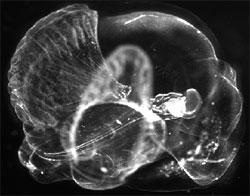Appendicularia facility
Oikopleura dioica is a pelagic urchordate with favourable features for genetic, genomic and embryological studies.
Main content
The appendicularia, an important class of metazoans near the transition from invertebrates to vertebrates, represent a new biological model with significant advantages in overcoming the problems described above. Despite the evolutionary complexity of the animal, its genome size is estimated to be only 3 to 4 times the size of the yeast genome.
An interesting feature of the animal is that it lives inside a house which it secretes from a terminally differentiated and highly specialized oikplastic epithelium. In the species we will be studying, this house is completely resynthesized every 3 to 4 hours, demonstrating a considerable capacity for high rates of protein synthesis. The house contains a complex set of inlet and feeding filters which allow the appendicularians to graze on a wide range of both decaying and living organic particles. There are at least 70 species world wide found over a depth range from the surface to greater than 2000 m. With their high filtering rates, capacity for rapid production blooms (up to 10-fold increase in biomass within 24 hours), and importance as a food source for marine fish populations, the appendicularia occupy a place of fundamental importance in marine ecosystems.
About the Model Organism Oikopleura dioica
About the appendicularian lab facility at the Sars Centre.
Contact Eric.Thompson@uib.no for more information.
